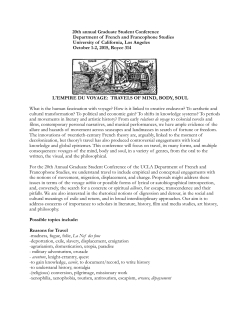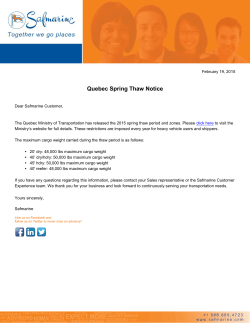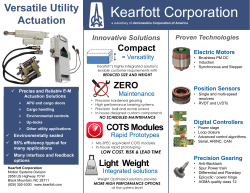
WHY TIME CHARTER EQUIVALENT (TCE) IS NOT
WHY TIME CHARTER EQUIVALENT (TCE) IS NOT EQUIVALENT TO TIME CHARTER HIRE Or FREIGHT IS A COMMODITY MARKET Time Charter Equivalent (TCE) Earnings The expenses of a shipping company fall into two categories. 1. The fixed daily costs: which arise every day of the year, regardless of the movement or employment of the ship, and are typically called daily costs in the shipping world. They can be listed as follows: depreciation, capital cost, crewing, technical maintenance (including drydocking), insurance and general administrative expenses. 2. The variable costs: which are the costs related to a voyage (sailing the ship, positioning or even waiting to load or discharge a cargo). They can be listed as follows: bunker (fuel) costs, port costs (including agent costs), canal transit fees, towage and pilotage. Even though they may occur every day, they are not daily costs because they vary hugely as they relate to the service being undertaken and in particular to the fuel consumption of the service undertaken. Waiting might consume only 5 MT of bunker oil a day whilst the consumption of oil when sailing depends on whether the ship is empty (ballast) or laden (with a cargo on board), how much cargo is on board and the speed the ship is sailing. Indeed, consumption is also affected by weather conditions and currents. In ballast, at low speed, in fair weather, the consumption might be as low as 30 MT per day but laden, at high speed, in heavy weather, it could be closer to 100 MT per day. For commercial and business management purposes the variable costs of any voyage are deducted from the Freight lump sum (paid by the cargo owner) to derive a Net Freight amount because these costs are variable with the particularities of the voyage performed, i.e. cargo size, distance, number of ports, etc. The Net Freight amount can then be divided by the number of days that the voyage took to perform (including the time and voyage expenses of positioning of the ship from the last port it discharged a cargo to the port where it will take a new cargo) and this establishes a daily rate of income, which is called the Time Charter Equivalent Earnings (TCE Earnings) which is expressed in USD/day. The TCE/day formula can be expressed in the following way: 𝑵𝑵𝑵𝑵𝑵𝑵 𝑭𝑭𝑭𝑭𝑭𝑭𝑭𝑭𝑭𝑭𝑭𝑭𝑭𝑭 (𝑖𝑖. 𝑒𝑒. 𝑭𝑭𝑭𝑭𝑭𝑭𝑭𝑭𝑭𝑭𝑭𝑭𝑭𝑭 𝒍𝒍𝒍𝒍𝒍𝒍𝒍𝒍 𝒔𝒔𝒔𝒔𝒔𝒔 − 𝑣𝑣𝑣𝑣𝑣𝑣𝑣𝑣𝑣𝑣𝑣𝑣𝑣𝑣𝑣𝑣 𝑐𝑐𝑐𝑐𝑐𝑐𝑐𝑐𝑐𝑐) = 𝑻𝑻𝑻𝑻𝑻𝑻/𝒅𝒅𝒅𝒅𝒅𝒅 𝑛𝑛𝑛𝑛𝑛𝑛𝑛𝑛𝑛𝑛𝑛𝑛 𝑜𝑜𝑜𝑜 𝑑𝑑𝑑𝑑𝑑𝑑𝑑𝑑 ∗ *from ship leaving port after discharge previous cargo until discharge current cargo The TCE Earnings can be compared to the daily hire paid under fixed term contract which is called daily Time Charter Hire. However, although comparable, TCE Earnings are not the same as Time Charter Hire. The Time Charter Hire is a definite and certain amount that is known when the contract is signed. The TCE is a calculated number which is not known until all of the income for the voyage has been received and all of the expenses paid. Only then the expenses can be netted off from the Freight lump sum in order to arrive to the Net Freight of the voyage. The duration of the voyage is also not certain. If due to bad weather the voyage took longer than expected, the earnings will be less than expected because more bunkers will be consumed and the duration will lengthen so the Net Freight is lower and will be divided by more days. So Voyage Charter, where performance is measured in terms of TCE Earnings, is significantly different to Time Charter, where daily hire rate is fixed and certain from the start of the contract. The choice of the speed is more complex than it appears The single largest variable cost of a voyage is the bunkers and this varies in direct relationship to the speed at which the voyage is performed. The speed of the laden part of the voyage is agreed with the charterer when the voyage charter is negotiated. The ship owner or, if there is one, the time charterer chooses the speed of the vessel for the ballast voyage (when the ship is empty of cargo) sailing the ship to a position where it can load a cargo for the Voyage Charter. In both cases the slower the ship, the lower the fuel cost as consumption will be lower and the faster the ship, then the higher the fuel consumption and therefore the cost. The slower a ship sails, the longer the voyage (more days) but the less fuel it consumes. So the calculation of the TCE will be affected in two ways (as the Freight lump sum remains the same). The Net Freight will go up because of the savings made on the fuel but at the same time it will be divided by more days taking the TCE down. Therefore a ship should only go slower if the cost of fuel, saved by slower sailing, offsets the reduction of the TCE caused by the increase in the number of days the voyage lasted. Finally, if the fuel cost saving justifies slower sailing then the owner will look to the lost opportunity of the days that could have been spent on the next voyage compared with the improvement in TCE from slower steaming on the current voyage. This is a very important point but the decision must be taken at the start of a voyage (the start of the ballast passage - see Voyage Accounting below) but this is done on the basis of unpredictable assumption regarding the next voyage. At that moment, the current Voyage Charter may not already have been fixed let alone the one after. Consequently, it is good practice upon discharge to sail at the most economical speed away from the discharge port to a way point (the last point at which the ship has full optionality as to its destination). As an example, on leaving China, this might be Singapore for orders. During this period the vessel is being marketed for its next Voyage Charter. Once the Voyage Charter is contracted, the vessel should proceed at such a speed so as to arrive at the port just in time to load the contracted cargo. It serves no purpose to arrive earlier as waiting adds additional costs against which there is no certain additional income. So in this example arriving early worsens the voyage TCE Earnings. More fuel is consumed going faster and if the ship arrives too early fuel is consumed waiting (to provide minimum energy to run the ship) and there is no additional income. If an earlier cargo lifting date could be contracted then the issue is whether it would add sufficient additional income to offset the additional cost of fuel for sailing faster. Still, if it does not, then arguably, the days gained may translate into more value in the subsequent voyage but with a high degree of uncertainty which will be lifted only two or more months away and in a market subject to huge volatility. In addition, speeding up means that the global supply of ships is also going up and that, in itself, is likely to reduce the freight market. There is therefore more chance that the value burned in speeding up will NOT be recuperated in the subsequent voyage as there is more chance that the market will be lower by then. In this context it is also important to note that the consumption of fuel, relative to speed, is not uniform and at the top speeds ships consume exponentially more fuel. For VLCC vessels, there is an inflection point above 13 knots and steaming above this speed, to save a few days, will disproportionately increase the voyage expense compared to the number of days saved. It’s a Commodity Stupid! The owner or time charterer of a vessel should always manage bunker costs, as described above, by sailing as slowly as the pattern of trade it is involved in allows. When deciding the speed, at which to sail from a discharge port, the market environment is very important. The world VLCC fleet is small, only around 630 vessels, and each ship will lift somewhere around 5 to 6 cargoes per year depending on the trade and move those cargoes over long distances. So for any cargo movement the number of ships available to load the cargo due to location and timing may vary considerably. This is very different from even other tanker trades that are short haul such as the product trades or localized dirty trades in smaller ships. Many participants and investors follow the global supply of ships and try to present the market as a bull or bear market depending on the overall supply of ships compared to the overall demand for ships. They are often confounded by a precipitous fall in rates in what they have characterized as a bull market; equally they are often denying the possibility of high fixtures in what they have characterized as a bear market. Yet when one reviews past fixtures it is apparent that the market can have very large swings within both peak and trough periods. Average earnings between 2004 and 2008 (inclusive) for VLCCs were USD 70,000 per day yet within that period voyages were done at USD 300,000 and USD 20,000 and within days, swings could make a difference of tens of thousands of dollars. 250,000 Daily average tankers freight rate between 2004-2008 USD/DAY 200,000 150,000 100,000 50,000 Average VLCC 2000-built okt/08 jul/08 apr/08 jan/08 okt/07 jul/07 jan/07 apr/07 okt/06 jul/06 apr/06 jan/06 okt/05 jul/05 apr/05 jan/05 okt/04 jul/04 apr/04 jan/04 0 Average Suezmax 2000-built Source: Clarksons This apparent super volatility comes about through the structure of the market. As described above, the earnings of ships come from the movement of cargoes. So when transport is required for a cargo, the cargo owner will instruct the internal shipping department of the cargo owner, who will in turn approach several brokers and sometimes owners directly and will seek to auction the cargo move. The lowest bidder will win the contract, or at least, set the contract rate that clears the market for the other bidders. Each broker hoping to make a commission on the contract conclusion will encourage his owner to be low enough to win the auction. The owners will be guided as to who else is bidding and how low they have to bid to succeed. The owners must have good information to know who is a real competitor and who is not. To be a real competitor a ship must be of the right age, type and class and be acceptable for the customer under the tanker vetting regime. It should also be reliable and so only those ships which are free of cargo and close enough to reach the load port at which the cargo is being prepared on the dates that the cargo owner has specified can realistically compete. This creates a mini market for each and every cargo, which comprises those ships that can work that cargo. This mini market is defined by time and distance. If many ships are truly available for the cargo, the mini market auction will take the current market level down, if the number of ships truly available is limited or only one, then provided the owner is aware of this, the market level will go up. This is regardless of the global supply of tankers. The owner is at a disadvantage as the auction is controlled by the cargo owner and because of that, the cargo owner has all the bids. The cargo owner also knows which ships are cleared for him to use and what other cargoes also need to be moved. There is no uniformity of information relating to bids or availability. The owner must have a view on that balance if the true value of the ships position, the commodity, is to be discovered particularly when the market is set so that it could go up. This is the true added value of a pool as it increases market visibility through better information and broadens market knowledge improving pricing. Speed is critical in the management of the spot market, as speeding up (and remember this worsens voyage economics) serves a negative purpose if it accumulates the number of ships bidding on a cargo (increase the supply). It worsens the economics of the voyage that is about to be done and takes the whole market level down. So ship owners and time charterers need to focus on bunker cost management and only speed up when a voyage has been fixed and then only sufficiently to arrive just in time for the cargo loading dates. The ship owner dilemma Too many ship owners focus on their relative outperformance; whether they do better than other ship owners. Often this leads them to undersell their services in the hope of perceived marginal gains (making sure they get a cargo sooner than later) over the other ship owners. But giving a discount to their services is detrimental because each Voyage Charter is a separate commodity negotiation which needs to be priced, as precisely as possible, to gain real absolute value giving good return to capital. By underselling their services, they may cut waiting time but often the discount is greater than the cost of waiting for the next cargo priced at a higher market. In the long run, the reason why relative value is irrelevant is simply that weak performance does not cause ships to leave the market as demonstrated over the last cyclical downturn. Relative outperformance will almost never deliver appropriate reward to capital… it just lowers the market for all. The only way to resolve this dilemma is to be part of a large platform such as a pool which is actively marketing available tonnage every day. As Euronav transitions to greater public ownership, it will continue to attempt to lead the market in focusing on the requirement for a good return on capital. Shipping is a capital intensive business and if the right returns are not given to capital then the industry will struggle to find access to capital whilst providing the necessary stability in the industry to bring security of supply, increasing environmental awareness, safe and rewarding conditions for employment, in short all of the things that the world expects. Time Charter A time charter is a lease of a ship by an owner to a lessee (known as a charterer) for a period of time (rather than the performance of a voyage) and paid for by a daily rate of hire usually an agreed dollar amount for each day and pro rata for each part of a day. The time charter daily hire covers the cost of the ship and its crew together with all cost and expenses for the ship to operate. The service provided is to operate the ship to steam the ship between ports, load, store, transport and deliver the cargo under the orders of the time charterer. The costs specifically related to the charterers orders in steaming between ports, loading, storing, transporting and discharging the cargo are known as the voyage related costs and are consequently for the account of the time charterer. Voyage Charter The carriage of a specific cargo from a load port (typically a terminal at an oil field) to the discharge port (typically a terminal at a refinery) is called a voyage or spot charter for which the cargo owner pays a lump sum usually denominated in US Dollars (it is calculated usually using a system called world scale). The voyage related costs comprise primarily bunker fuel but also port costs, tugs, pilots and any other thing incidental to the cargo carriage. The ship owner, or if there is a time charter, the time charterer will seek to recuperate these costs from the freight paid by the cargo owner but these costs are not a pass through and do not form part of the negotiation. Voyage Accounting The cargo owner is only interested in the movement of the cargo but the ship owner must reposition the ship after discharging one cargo and before loading another cargo. The costs for this repositioning must be taken into account in the costs of performing the cargo transportation. In most cases it is elected to apply the repositioning costs to the cargo transport just about to be done. In other words a complete accounting voyage is, in most cases, from discharge port to discharge port. The ‘actual’ voyage commences after leaving the last discharge port sailing unladen to a load port, entering that port, loading the cargo and sailing to the discharge port, entering that port and discharging the cargo. The process then starts again.
© Copyright 2025









